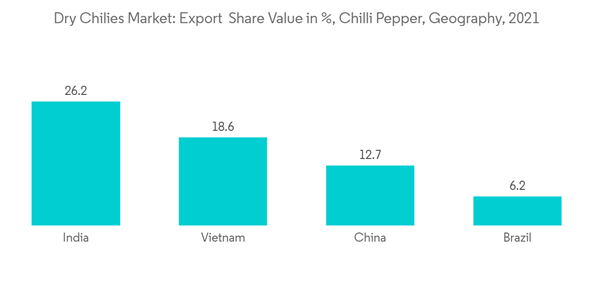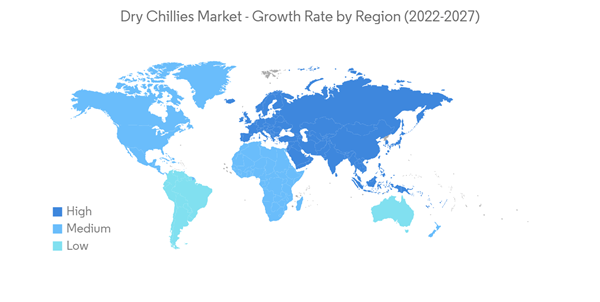Key Highlights
- Asia-Pacific dominates the market, as India is the world's largest producer, consumer, and exporter of dry chilies. India's top importers are China, the United States, Thailand, Sri Lanka, and Indonesia. Andhra Pradesh is the primary producer of chilies in the country, followed by Karnataka, Rajasthan, and Gujarat. Chilies are grown for various uses, including vegetables, spices, condiments, sauces, and pickles.
- The government is also implementing various schemes to supply farm inputs, like seeds, fertilizers, agricultural machinery & equipment, irrigation facilities, etc., at subsidized rates to the farmers in the country.
- Some of the major factors driving the market include the increasing demand for dry chilies in western regions like Europe. Europe is one of the largest importers of dry chilies globally, as the production in the region is not self-sufficient. Europe produces less than 80 thousand metric tons of dried chilies and other dried paprika, accounting for half of the imports. Therefore, it is highly dependent on Asian countries for imports. The Asia-Pacific region is also anticipated to achieve a faster growth rate over the forecast period.
Dry Chillies Market Trends
High Demand for the Exotic and Spicy Oriental Dishes
- Increasing disposable income and the growing trend of traveling to Asian countries have had a huge impact on the demand for Asian cuisine and culture. Earlier, western cuisines were more favored and popular.
- For example, the influence of Indian, Thai, and Indonesian cuisine is reflected in Malaysian food, from their use of wok to the mix and match of fresh herbs and spices. India is one of the leading manufacturers of red chili powder, which is prepared from dry red chili and available in abundant quantities and varieties in India.
- Fusion dishes are an additional trend in Asian cuisine that keeps expanding yearly. Fusion cuisine is a uniquely American invention that combines several well-known flavors from other countries to create a brand-new meal.
- The food truck culture in Southern California, which developed out of the area's diverse population and gave rise to dishes like bulgogi tacos, is the place where this trend is most obvious. This unusual dish from a food truck combines traditional Mexican cuisine with sweet and sour Korean beef and is topped with creamy gochujang chili sauce.
- Gochujang, a red chili-based fermented sauce that gives savory foods a sweet and spicy kick, is on the path to replace Sriracha as it gains popularity and spreads from Korean restaurants and food trucks to mainstream supermarkets all over the United States. The market value of chili tends to rise quickly as a result of the rising demand for spicy foods and cuisines in nations like the United States, Mexico, Korea, Malaysia, and Europe. This will raise the exports of chili from Asian nations, where production is higher than in any other region.
- Therefore, increasing the demand for cuisine and restaurant foods and consumer demand for flavored foods will raise the growth of the dry chili market, which will be anticipated to grow in the coming years.
Asia-Pacific Dominates the Market
- Asia-Pacific dominates the market, as India is the world's leading producer and exporter of dry chilies, accounting for more than 26.2% in 2021, followed by Vietnam, China, and Indonesia. In recent years, the production of dry chilies in Asian countries has decreased slightly or remained more or less stable.
- Based on data from Food and Agriculture Organization (FAO), the production of dry chilies in China remained stable over the last four years. In contrast, in Thailand, India, and Pakistan, production decreased. However, the dry chilies market in the Asia-Pacific region is anticipated to grow during the forecast period, owing to the rising demand for dry chilies worldwide.
- Among other major producers, India is the world's top producer and consumer of chili. It accounts for 36% of global production and continues to lead in international trade, exporting approximately 30% of its overall output. The demand for the world-famous Sannam S4 dry red chilies is very high worldwide. It is grown in the states of Andhra Pradesh, Rajasthan, Maharashtra, Assam, and Madhya Pradesh. Red Chilli 334(S4) increased demand coming from Bangladesh, and masala millers from South India are often used for Indian, Chinese, European, Thai, and Italian cuisines.
- Based on data from Food and Agriculture Organization Corporate Statistical Database (FAOSTAT), the production of dry chilies in India witnessed a decreasing trend in recent years. In 2019, the production was reported at 1,743,000 metric tons, which declined to 1,702,000 metric tons in 2020. However, as the demand from the west is increasing rapidly, the dry chilies market in India is expected to grow during the forecast period.
Dry Chillies Industry Overview
Additional Benefits:
- The market estimate (ME) sheet in Excel format
- 3 months of analyst support
This product will be delivered within 2 business days.










